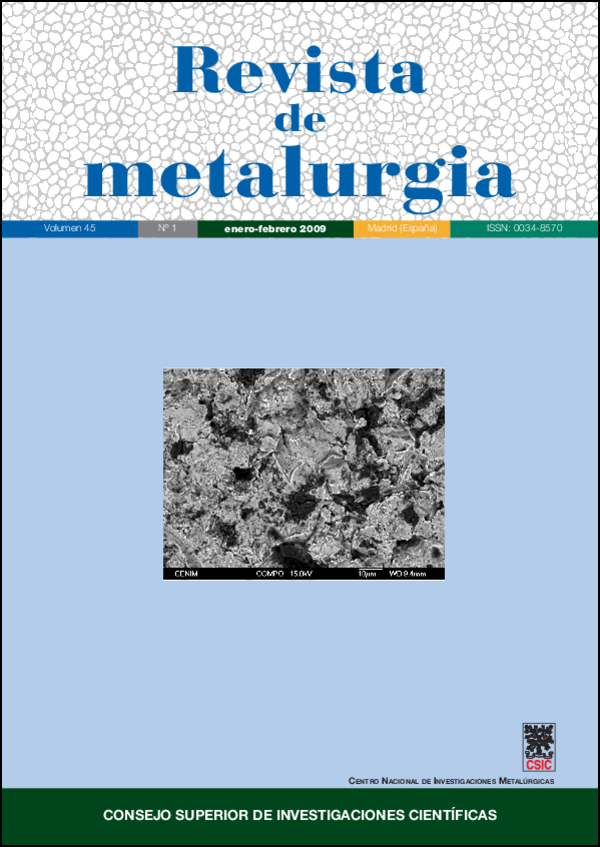Comparative study of the electrochemical behaviour of iron in alkaline media containing red mud and grey slurries. The effect of Al3+
DOI:
https://doi.org/10.3989/revmetalm.0672Keywords:
Red mud, Grey slurries, CV, EIS, Corrosion inhibitorAbstract
Red mud (RM) is the main by-product of the Bayer process for alumina extraction from bauxite, and grey slurries (GS) are generated during the granite rocks transformation processes. The huge volume of those wastes generated every year suppose a serious environmental problem. Recent works by our group demonstrate the efficiency of both types of muds as corrosion inhibitors for iron and steel in alkaline media containing chlorides. The elemental analysis of these slurries shows that Al3+ is the main common element. Therefore, the aim of this paper is to study the effect of the soluble Al3+ in the electrochemical behaviour of iron in alkaline media, in presence and absence of chlorides. The electrochemical study using Cyclic Voltammetry (CV) and Electrochemical Impedance Spectroscopy (EIS) together with surface analysis techniques allowed to conclude that Al3+ blocks the surface of steel in alkaline media chloride increasing the steel resistance to chloride attack.
Downloads
References
[1] B. Díaz, S. Joiret, M. Keddam, X.R. Nóvoa, M.C. Pérez y H. Takenouti, Electrochim. Acta 49 (2004) 3.039.
[2] C.M. Abreu, M.J. Cristóbal, L.Freire, X.R. Nóvoa, G. Pena y M.C. Pérez, J. Br. Chem. Soc. 6 (2007) 1.158.
[3] E. López, B. Soto, M.Arias, A. Nuñez, A.D. Rubinos y M.T. Barral, Water Res. 32 (1998) 1314. doi:10.1016/S0043-1354(97)00326-6
[4] J.P. Gonçalves, W.A. Moura y D.C. Coitinho dal Molin, Ambiente Construido 2,1 (2002) 53.
[5] J.M.S. Moreira, M.N. Freire y J.N.F. Holanda, Cerámica 49 (2003) 262. doi:10.1590/S0366-69132003000400012
[6] A. Collazo, M.J. Cristóbal, X.R. Nóvoa, G. Pena y M.C. Perez, J. ASTM Int. 3, 2 (2006) 1.
[7] M. Cabeza, A. Collazo, X.R. Nóvoa y M.C. Pérez, J. Corros. Sci. Eng. 6 (2003) CO77
[8] C. Andrade, P. Merino, X. R. Nóvoa, M. C. Pérez y L. Soler, Mater. Sci. Forum192-194 (1995) 891. doi:10.4028/www.scientific.net/MSF.192-194.891
[9] M. Pourbaix, Atlas d’équilibres électrochimiques, Gauthier-Villars Ed. Paris, (1963) p. 170.
[10] P. Pedeferri, Construc. Build. Mater. 10 (1996) 391. doi:10.1016/0950-0618(95)00017-8
[11] D. Izquierdo, C. Alonso, C. Andrade y M. Castellote, Electrochim. Acta 49 (2004) 2.731.
[12] S. Joiret, M.Keddam, X.R. Nóvoa, M.C. Pérez, C.Rangel y H. Takenouti, Cem. Concr. Compos. 24 (2002) 7. doi:10.1016/S0958-9465(01)00022-1
[13] C.Andrade, M. Keddam, X.R. Nóvoa, C.M. Rangel y H.Takenouti, Electrochim. Acta 46 (2001) 3.905.
[14] C.M. Abreu, M.J. Cristobal, R. Losada, X.R. Nóvoa, G. Pena y M.C. Pérez, J. Electroanal. Chem. 572 (2004) 335. doi:10.1016/j.jelechem.2004.01.015
[15] C. Exartier, S. Maximovitch y B. Baroux, Corros. Sci. 46 (2004) 1.777.
Downloads
Published
How to Cite
Issue
Section
License
Copyright (c) 2009 Consejo Superior de Investigaciones Científicas (CSIC)

This work is licensed under a Creative Commons Attribution 4.0 International License.
© CSIC. Manuscripts published in both the printed and online versions of this Journal are the property of Consejo Superior de Investigaciones Científicas, and quoting this source is a requirement for any partial or full reproduction.
All contents of this electronic edition, except where otherwise noted, are distributed under a “Creative Commons Attribution 4.0 International” (CC BY 4.0) License. You may read the basic information and the legal text of the license. The indication of the CC BY 4.0 License must be expressly stated in this way when necessary.
Self-archiving in repositories, personal webpages or similar, of any version other than the published by the Editor, is not allowed.
















